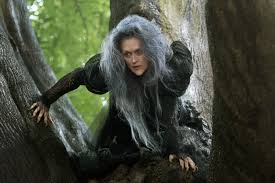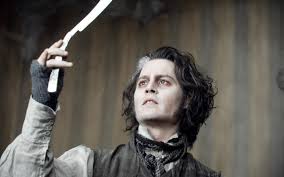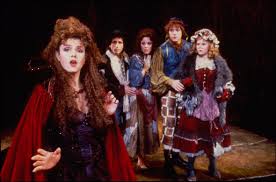Based on the commentary I was seeing in online articles and social media comments yesterday, someone had just painted a mustache on the Mona Lisa. No one seemed to care that Da Vinci had decided to it himself.
 I’m referring to the outpouring of dismay over the news that some changes had been made to the storyline and score of Disney’s upcoming film of Stephen Sondheim’s Into The Woods. Mind you, no one has seen the film as of yet; the response resulted from a New Yorker “Talk of the Town” piece in which Sondheim spoke of the changes, and more to the point, from online articles based on that story which extracted out the specifics of the pending changes without the full context of the original report, which regrettably is behind The New Yorker’s paywall. Therefore it’s the secondhand reportage which seems to have reached the widest audience and sparked a healthy flurry of unhappiness.
I’m referring to the outpouring of dismay over the news that some changes had been made to the storyline and score of Disney’s upcoming film of Stephen Sondheim’s Into The Woods. Mind you, no one has seen the film as of yet; the response resulted from a New Yorker “Talk of the Town” piece in which Sondheim spoke of the changes, and more to the point, from online articles based on that story which extracted out the specifics of the pending changes without the full context of the original report, which regrettably is behind The New Yorker’s paywall. Therefore it’s the secondhand reportage which seems to have reached the widest audience and sparked a healthy flurry of unhappiness.
I for one would like to state that I’m shocked – shocked, I say – to find that the creative and commercial forces behind the film adaptation of a stage work have mandated changes in the original material (for those immune to written sarcasm, I mean to say that I’m not remotely shocked). The litany of stage material (or for that matter books, true life stories and even prior films) that has been slightly altered or radically reworked for movie consumption is endless. But even minor changes become the fodder for endless online investigation, interpretation and instantaneous outrage, the currency of so much digital derision by the faithful. And it’s not even an online phenomenon – I remember the furor that arose when Tim Burton had the temerity to cast Michael Keaton as Batman in the 80s, even for what was a major reworking of material that had been reduced to camp 20 years earlier on television.
 That Disney might want to homogenize some of the spikier elements of Into The Woods should have come as no surprise to anyone familiar with the company’s brand, which has a long history of altering fairytale stories, from Snow White and Sleeping Beauty to Once Upon A Time and Maleficent. Yes, I am one of the many who revere Sondheim’s work, and the man, but just as the removal of “The Ballad of Sweeney Todd” from that film adaptation didn’t ruin the story on screen, I’m at least willing to wait to see Into The Woods before I critique its choices, whatever the rationale. And let’s face it, after almost 30 years, it’s not as if film companies were fighting for the right to bring the material to the screen.
That Disney might want to homogenize some of the spikier elements of Into The Woods should have come as no surprise to anyone familiar with the company’s brand, which has a long history of altering fairytale stories, from Snow White and Sleeping Beauty to Once Upon A Time and Maleficent. Yes, I am one of the many who revere Sondheim’s work, and the man, but just as the removal of “The Ballad of Sweeney Todd” from that film adaptation didn’t ruin the story on screen, I’m at least willing to wait to see Into The Woods before I critique its choices, whatever the rationale. And let’s face it, after almost 30 years, it’s not as if film companies were fighting for the right to bring the material to the screen.
What frustrates me much more in this scenario is the way in which the details of changes have been excised from their context in The New Yorker. Sondheim’s revelation came out of a conversation with high school teachers which touched upon some of the problems they face in trying to produce challenging work at their schools, by Sondheim and others. While reporter Larissa MacFarquhar is glib about opposition to Sweeney Todd (“the teachers were smut and gore idealists”), she does report on the portion of the conversation specific to Into The Woods. In particular, she relates how the teachers told stories of opposition to elements of infidelity and sexuality in the Sondheim-Lapine piece, and how Sondheim compared the attitudes of school administrators to those of Disney executives. (I asked the organization that arranged the conversation, the Academy for Teachers, whether a recording of the full session had been created, but founder Sam Swope said they had none, that the New Yorker account was accurate and that the censorship discussion was only a small part of a wider-ranging talk.)
When a teacher explains that she must always present bowdlerized versions of musicals (please look up that odd word if you don’t know it), the article reports:
“Can you let them read the original and then discuss why, say, Rapunzel is not allowed to die in the adulterated version?” Sondheim asked.
“We do that, but they just get angry. They feel censored–they don’t feel trusted.”
“And they’re right,” Sondheim said. “But you have to explain to them that censorship is part of our puritanical ethics, and it’s something that they’re going to have to deal with. There has to be a point at which you don’t compromise anymore, but that may mean you won’t get anyone to sell your painting or perform your musical. You have to deal with reality.”
Now I’m not entirely comfortable with Sondheim’s conflation of censorship with marketplace realities, since censorship is performed unilaterally by people in power against those without influence, whereas creative alteration in a commercial setting results from negotiation – and money is at the root of the decisions on all sides. Into The Woods wasn’t taken unwillingly from Sondheim – he sold it. I trust that he has safeguarded the essence of the show. But I agree that the impulse to homogenize for the marketplace does indeed come from a puritan ethic, as does school censorship, both cases where adults take a patronizing view of what young people can handle – though in the case of a Disney film, they’re trying to reach audiences much younger than the participants in high school theatre programs in a big tent effort.
 It is the stage alteration in schools that perpetually worries me. In cases when creators or rights holders have authorized “junior”or “school” versions of stage works, they are active participants in the excision of “challenging” material,” and while perhaps that’s also a market-driven decision, I like to think that it also occurs in the best interests of allowing to students to take on work which would otherwise be wholly off-limits in a school setting. Regardless, I worry about the academic gatekeepers who mandate these changes, which may vary from school to school or state to state, and in far too many cases are done at the school level without any approval from the licensing house or creator. That’s where censorship is truly taking place and insidious. It’s where the idea that anyone can alter a stage text at will is born, much to the consternation of authors, and their representatives at the Dramatists Guild, in the U.S.
It is the stage alteration in schools that perpetually worries me. In cases when creators or rights holders have authorized “junior”or “school” versions of stage works, they are active participants in the excision of “challenging” material,” and while perhaps that’s also a market-driven decision, I like to think that it also occurs in the best interests of allowing to students to take on work which would otherwise be wholly off-limits in a school setting. Regardless, I worry about the academic gatekeepers who mandate these changes, which may vary from school to school or state to state, and in far too many cases are done at the school level without any approval from the licensing house or creator. That’s where censorship is truly taking place and insidious. It’s where the idea that anyone can alter a stage text at will is born, much to the consternation of authors, and their representatives at the Dramatists Guild, in the U.S.
 As Sondheim notes in the New Yorker piece, “If you look at most plays, it’s like the sonata form in music–if you screw around with that, you’re taking your life in your hands.”
As Sondheim notes in the New Yorker piece, “If you look at most plays, it’s like the sonata form in music–if you screw around with that, you’re taking your life in your hands.”
It is clear in the article that Sondheim is an active participant in the film of Into The Woods, whether his resulting choices are grudgingly mercenary or willingly collaborative is hard to assess. Regarding the removal of the Baker’s Wife’s liaison and the song “Any Moment,” the article reports one educator’s distress and Sondheim’s acquiescence.
“Stick up for that song!” a teacher called out.
“I did, I did,” Sondheim said. “But Disney said, we don’t want Rapunzel to die, so we replotted it. I won’t tell you what happens now, but we wrote a new song to cover it.”
As with any adaptation of a prior work, changes are inevitable. Fortunately, the new version doesn’t change the source, and in the case of Into The Woods, Disney’s film won’t yield a whole new stage text. I do worry that schools will interpret the screen revisions as permission to alter their own productions, which is in fact illegal; I’ve been struck by how often opposition to Sweeney Todd has arisen from the film’s gouts of bloods, which suggest that gore is essential to the show, when even John Doyle’s Broadway revival dispensed with obvious blood-letting, so the films do suggest a template to the public. What is very likely to occur from the Into The Woods film is that people beyond the core fan base for musicals will be introduced to the genius of Sondheim and, perhaps, that even more schools will do the show – according to the approved text.
It may be fun join in online outrage, but it’s an impotent act in a case like this. The film will be what Disney wants it to be. Why not put those efforts to better use, and direct them to supporting live theatre and making sure that the teachers whose genuine concerns sparked this kerfuffle have the opportunity to tackle brilliant and challenging work with their students, their schools and their communities. That’s where your voice can make a difference, in advancing the cause of arts education and in the battle against true censorship whenever it arises.
Addendum, June 23, 2014: One week after The New Yorker article came out and five days after the online furor began, Stephen Sondheim released the following statement about changes to Into The Woods, which largely negates the cuts he said would be happening. It reads:
An article in The New Yorker misreporting my “Master Class” conversation about censorship in our schools with seventeen teachers from the Academy for Teachers a couple of weeks ago has created some false impressions about my collaboration with the Disney Studio on the film version of Into the Woods. The fact is that James (Lapine, who wrote both the show and the movie) and I worked out every change from stage to screen with the producers and with Rob Marshall, the director. Despite what the New Yorker article may convey, the collaboration was genuinely collaborative and always productive.
When the conversation with the teachers occurred, I had not yet seen a full rough cut of the movie. Coincidentally, I saw it immediately after leaving the meeting and, having now seen it a couple of times, I can happily report that it is not only a faithful adaptation of the show, it is a first-rate movie.
And for those who care, as the teachers did, the Prince’s dalliance is still in the movie, and so is “Any Moment.”



